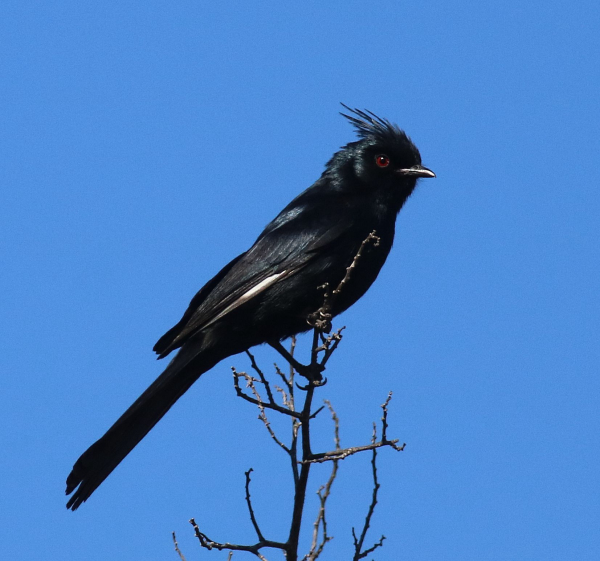
A male Phainopepla photographed on the edge of coastal woodland habitat in southern California by Paul Konrad.
|
Reproduction and migration are the two most demanding activities in a bird’s life, and the vast majority of species separate them into different times of the year, and nest during just one season. For decades, biologists knew that some Phainopeplas nest in the desert during spring month, and that Phainopeplas inhabiting coastal woodlands nest during summer. But could these “two populations” actually consist of the same birds?
Only two bird species are known to undertake what ornithologists describe as “itinerant breeding;” that is, they nest in one area, migrate to another region, and nest again there within the same year to take advantage of available food resources in both locations. New research just published in the scientific journal The Auk: Ornithological Advances provides strong evidence that Phainopeplas may also practice itinerant breeding.
Phainopeplas are a species of tropical Silky Flycatchers that range north into areas of the southwest United States. In 2017, Princeton University’s Daniel Baldassarre (now an Assistant Professor at State University of New York at Oswego) and his colleagues captured 24 adult Phainopeplas that were nesting in the Mojave Desert during March and April and fitted them with tiny GPS transmitter tags. To download the GPS location data and see where the Phainopeplas went, they needed to recapture the same birds. Fortunately, 5 of the 24 birds returned to the same site that fall and were recaptured. The GPS data showed that all 5 of the recaptured birds had migrated to coastal woodland habitats during the summer months.
“Seeing the GPS tracking for the first time was amazing, but the biggest thrill for me was re-sighting the first tagged bird that returned to the capture site,” explained Baldassarre. “We were a bit unsure how likely they were to come back to the same spot, so to see that a tagged bird had returned was an exhilarating moment. When he hit the net it was like, okay, we’re in business here.”
Circumstantial evidence has long raised suspicions that Phainopeplas might be itinerant breeders. Phainopeplas are vocal mimics, and birders observed individual birds in desert habitats mimicking species found in woodland habitats and vice versa. The GPS data from this study still doesn’t completely prove that Phainopeplas are itinerant breeders because the researchers were not able to directly observe tagged birds nesting in coastal woodlands. However, Baldassarre and his colleagues were able to further support their conclusions with DNA analysis showing that desert-nesting Phainopeplas and woodland-nesting Phainopeplas are not genetically different.
“I approached this just thinking about it being a cool species and a rare behavior, but as I started to consider the bigger picture, I realized that the sort of flexibility that itinerant breeding species like this seem to be capable of is also interesting from a climate change perspective,” said Baldassarre.
“It suggests that they might be able to deal with climate change better than other birds. They’re highly mobile, they can modulate their physiology to go between migratory and breeding periods quickly, and they can deal with different physical and social environments. It makes this interesting beyond just being a weird bird behavior,” he explained.
The scientific publication that this article is based on can be referenced in The Auk as: Daniel Baldassarre, Leonardo Campagna, Henri Thomassen, Jonathan Atwell, Miyoko Chu, Lisa Crampton, Robert Fleischer, and Christina Riehl. GPS tracking and population genomics suggest itinerant breeding across drastically different habitats in the Phainopepla. The Auk, 2019.
To reference the original article in ScienceDaily, see https://www.sciencedaily.com/releases/2019/10/191015075314.htm